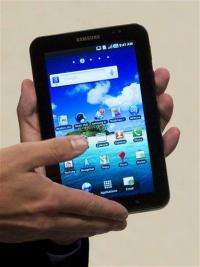Gift Guide: Tablet and e-reader buying advice

(AP) -- This holiday season, it will be hard to enter a store without setting eyes on a tablet computer or an e-reader. In both categories, big-name manufacturers - along with some you might not have heard of - are jumping on the bandwagon, trying hard to undercut each other with lower-priced gadgets.
It doesn't help that so many of them claim to do the same thing. The iPad dominates the field, but there's a slew of contenders that all run Google Inc.'s Android software, which is already common on smart phones. Meanwhile, the smaller tablets look almost indistinguishable from some new e-readers that hope to unseat the Kindle.
So which to buy? Here are the best options and some advice for figuring out which is the right choice for the person on your list.
E-readers:
Amazon Kindle (Wi-Fi only: $139; 3G: $189)
Pros: The Kindle's display, which measures 6 inches diagonally, uses "electronic-ink" technology, which makes it easy to read books, newspapers and magazines in direct sunlight. It falls somewhere between an iPhone and an iPad in size and weighs half a pound, making the device from Amazon.com Inc. thinner and lighter than Barnes & Noble Inc.'s Nookcolor, its strongest rival. The Kindle also lasts longer on a charge: up to one week with Wi-Fi on and two to three weeks with it turned off.
Cons: Screen is gray-scale only. The pages are slow to turn, and zooming and scrolling don't work. Lacks a built-in light source. Clunky built-in Web browser. Doesn't accept books from public libraries.
Barnes & Noble Nookcolor ($249)
Pros: Displays books and magazines in color. The brightness of the 7-inch touchscreen can be adjusted for comfortable reading in a wide range of lighting conditions. Besides a large library of books, magazines and newspapers, Barnes & Noble sells children's books with built-in narration tracks. Some books can be lent to friends, who can download Barnes & Noble's software for free to read them.
Cons: Children's books are expensive - $8, compared with child-friendly iPad apps that cost about $2. The screen is too small for comfortable reading of magazines. At 1 pound, it is twice as heavy as Amazon's Kindle, although still lighter than the iPad. Its battery life (eight hours with Wi-Fi turned off) is relatively short, although still sufficient for a round-trip flight across the country.
Tablets:
Apple iPad (Wi-Fi only: $499-$699; 3G: $629-$829)
Pros: Has the same intuitive interface as the iPhone and iPod Touch, but optimized for the iPad's larger 9.7-inch display. Syncs with the popular iTunes software, whose store sells music, movies and e-books. Up to 10 hours of battery life. There are more than 300,000 apps available in the app store; more than 40,000 of them were designed specifically for the iPad, making this the most versatile tablet, by far. All models connect over Wi-Fi, while 3G versions can use AT&T's cellular network, whose plans in the U.S. cost either $15 or $25 per month and require no long-term contracts.
Cons: It is relatively large and weighs about 1.5 pounds, so it's not as easy to use one-handed as a smaller tablet such as Samsung Electronics Co.'s Galaxy Tab. Lacks a camera for video chatting. Students will find fewer textbooks available in Apple Inc.'s iBooks than in Amazon's Kindle store.
Samsung Galaxy Tab ($399 with two-year contract; $599-$649 without)
Pros: The Tab runs the same Android software that can be found on many a smart phone. Solid build quality and brisk performance. It is a bit smaller than the iPad and about half its weight. It has dual cameras, something the iPad lacks entirely, allowing people to video chat, record HD movies and snap still photos. The Tab's display is sharper than the iPad's.
Cons: The Tab's 7-inch display makes for a less immersive movie-watching experience than the iPad's larger one. Many Android apps weren't designed to fill the Tab's larger screen. Video chat can be slow over both Wi-Fi and 3G cellular networks. The Tab only costs $399 if you commit to a two-year contract with Sprint or Verizon Wireless, which let the Tab run over their 3G networks. Verizon Wireless and AT&T sell the Tab with optional contracts, but it costs more up front ($599 on Verizon and $649 on AT&T). Monthly data plans range from $25 to $60.
©2010 The Associated Press. All rights reserved. This material may not be published, broadcast, rewritten or redistributed.





















